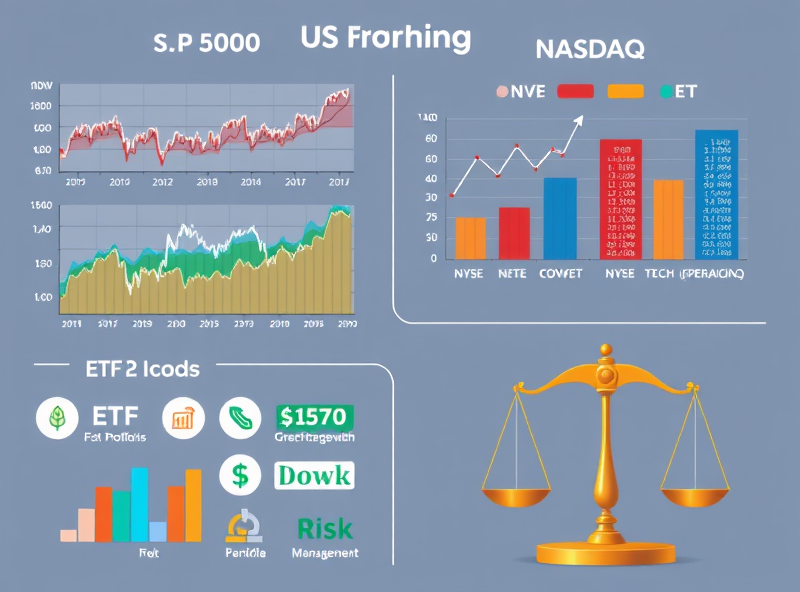Understanding Key Market Indices

When starting your journey as a beginner investor in US stocks, understanding key market indices is essential. Market indices, such as the S&P 500, Dow Jones Industrial Average (DJIA), and Nasdaq Composite, serve as benchmarks that track the performance of a specific group of stocks. These indices provide a snapshot of the overall market’s health and can help you gauge how your investments are performing relative to the broader market.
For example, the S&P 500 represents the 500 largest publicly traded companies in the US and is often considered a strong indicator of the US economy. The Dow Jones Industrial Average, on the other hand, focuses on 30 large, established companies, making it a more concentrated view of the market. Meanwhile, the Nasdaq Composite is heavily weighted toward technology and growth-oriented companies, offering insights into the tech sector’s performance.
By keeping an eye on these indices, you can make more informed decisions about your investments. They can help you identify trends, understand market sentiment, and evaluate whether the market is bullish (rising) or bearish (falling). As a beginner, it’s a good idea to familiarize yourself with these indices and follow their movements regularly. Over time, this knowledge will empower you to make smarter investment choices and build a more resilient portfolio.
Building a Strategic Investment Plan

When starting your journey into US stock investing, having a strategic investment plan is essential. Think of it as your financial roadmap—it helps you stay focused, disciplined, and aligned with your long-term goals. Here are some steps to build a strong investment plan:
1. **Define Your Goals**: Are you investing for retirement, a major purchase, or simply to grow your wealth? Knowing your ‘why’ will guide your decisions and keep you motivated.
2. **Assess Your Risk Tolerance**: Everyone has a different comfort level when it comes to risk. Are you comfortable with high-risk, high-reward investments, or do you prefer safer, more stable options? Understanding this will help you choose the right mix of stocks.
3. **Diversify Your Portfolio**: Don’t put all your eggs in one basket. Spread your investments across different sectors, industries, and even asset classes to reduce risk.
4. **Set a Budget**: Decide how much you can afford to invest without impacting your daily expenses or emergency savings. Start small if needed—consistency is more important than the amount.
5. **Do Your Research**: Before buying any stock, research the company’s financial health, industry trends, and market performance. Knowledge is power in the investing world.
6. **Monitor and Adjust**: The market changes, and so might your goals. Regularly review your portfolio and make adjustments as needed to stay on track.
Remember, investing is a marathon, not a sprint. Patience and discipline are key to building wealth over time. With a solid strategic plan, you’ll be better equipped to navigate the ups and downs of the stock market and achieve your financial goals.
Analyzing Companies for Long-Term Growth

When investing in US stocks, one of the most important skills to develop is the ability to analyze companies for long-term growth. This means looking beyond short-term trends and focusing on the fundamental factors that drive a company’s success over time. Start by reviewing the company’s financial health—key metrics like revenue growth, profit margins, and debt levels can provide valuable insights. A company with consistent revenue growth and manageable debt is often a strong candidate for long-term investment.
Next, consider the industry the company operates in. Is it part of a growing sector, such as technology or renewable energy? Understanding the broader market trends can help you identify companies that are well-positioned for future growth. Additionally, evaluate the company’s competitive advantage. Does it have a unique product, strong brand, or proprietary technology that sets it apart from competitors? Companies with a clear edge in their market are more likely to thrive in the long run.
Lastly, assess the management team. A capable and visionary leadership team can make a significant difference in a company’s performance. Look for evidence of strategic decision-making and a track record of delivering results. By combining these factors, you can make more informed decisions and build a portfolio designed for sustainable growth.
Effective Risk Management for Beginners

Investing in the stock market can be exciting, but it’s important to remember that every investment carries some level of risk. For beginners, managing risk effectively is a crucial skill to develop early on. Here are some practical tips to help you navigate the uncertainties of the market:
1. **Diversify Your Portfolio**: One of the golden rules of investing is diversification. Don’t put all your money into a single stock or sector. Instead, spread your investments across different industries, asset classes, and even geographical regions. This way, if one investment underperforms, others may balance it out.
2. **Set a Budget and Stick to It**: Determine how much money you can afford to invest without affecting your daily life or emergency savings. Never invest money you can’t afford to lose.
3. **Understand Your Risk Tolerance**: Everyone has a different comfort level when it comes to risk. Assess your financial goals, timeline, and emotional capacity to handle market fluctuations. If you’re risk-averse, consider safer investment options like index funds or bonds.
4. **Use Stop-Loss Orders**: A stop-loss order is a tool that automatically sells a stock when it reaches a certain price. This helps you limit potential losses and protect your capital.
5. **Keep Emotions in Check**: Emotional decisions can lead to poor investment choices. Avoid panic-selling during market downturns or chasing trends during market highs. Stick to your investment strategy and make decisions based on research and logic.
6. **Educate Yourself**: Knowledge is power in the world of investing. Take the time to learn about market trends, financial statements, and economic indicators. The more informed you are, the better equipped you’ll be to make sound decisions.
By implementing these risk management strategies, you can build a more resilient investment portfolio and approach the stock market with confidence. Remember, successful investing is a marathon, not a sprint. Take your time, stay informed, and make decisions that align with your long-term goals.



